
Around 1980, near the small village of Cần Giuộc in southern Vietnam, a single glass of water was centered on a table. Dinh Du and Hongyen Dao leaned in close, peering into it.
As a younger man, Dinh entered trade school and became a mechanic. He worked as a contractor for the U.S. Army while war raged through Vietnam in the late 1960s. One day, he repaired a bulldozer belonging to one of Hongyen’s relatives and was deemed “useful” by her family. Soon, the two were arranged to be married and bound to a life together. Dinh and Hongyen raised five children in Cần Giuộc, about 20 miles south of Saigon, what would become Ho Chi Minh City.
In the years after Saigon fell in April 1975, harsh government restrictions defined daily life in south Vietnam. Meals of soy sauce and oatmeal. Electricity limited to two days per week. The constant threat of being placed in re-education camps or relocated to New Economic Zones in the remote highlands. There was little work, less pay and no opportunity.
Dinh and Hongyen got by building and selling batteries. Dinh built them. Hongyen sold them. But desperation grew by the day.
So, there they sat, perched forward, looking at that glass. Out of options, Dinh and Hongyen sought the advice of a “coi bói,” or fortune teller. He was named “Mr. Seven” and revered by the locals. Dinh and Hongyen asked the only question on their minds: Should we attempt an escape?
Mr. Seven rolled up a piece of thread until it twined into a ball and told them in Vietnamese, “If it floats, you go. If it sinks, you stay.”
The ball of thread dropped. Then splashed. Then bobbed atop the water.
Mr. Seven nodded. He said that as long as Dinh built the boat, and as long as they stuck together, the escape would be successful.
Over the next two years, Dinh disappeared for weeks at a time. He drove two hours to Vũng Tàu, out by the coastline, and set about building his boat, acquiring one piece at a time. He strapped each board to his powder blue Vespa. Then drove it to Vũng Tàu. Then he got the next one. Back and forth he went. “Like an ant,” one daughter would later say.
Hongyen told the kids that their dad got a job far from home. In truth, he was working along the coast in secrecy, doing all he could to avoid police attention and the severe jail time if caught plotting a defection. Members of the công an, the public security branch of the Vietnam People’s Armed Forces, often came by the house looking for Dinh Du. Hongyen either lied or paid them off with money or food.
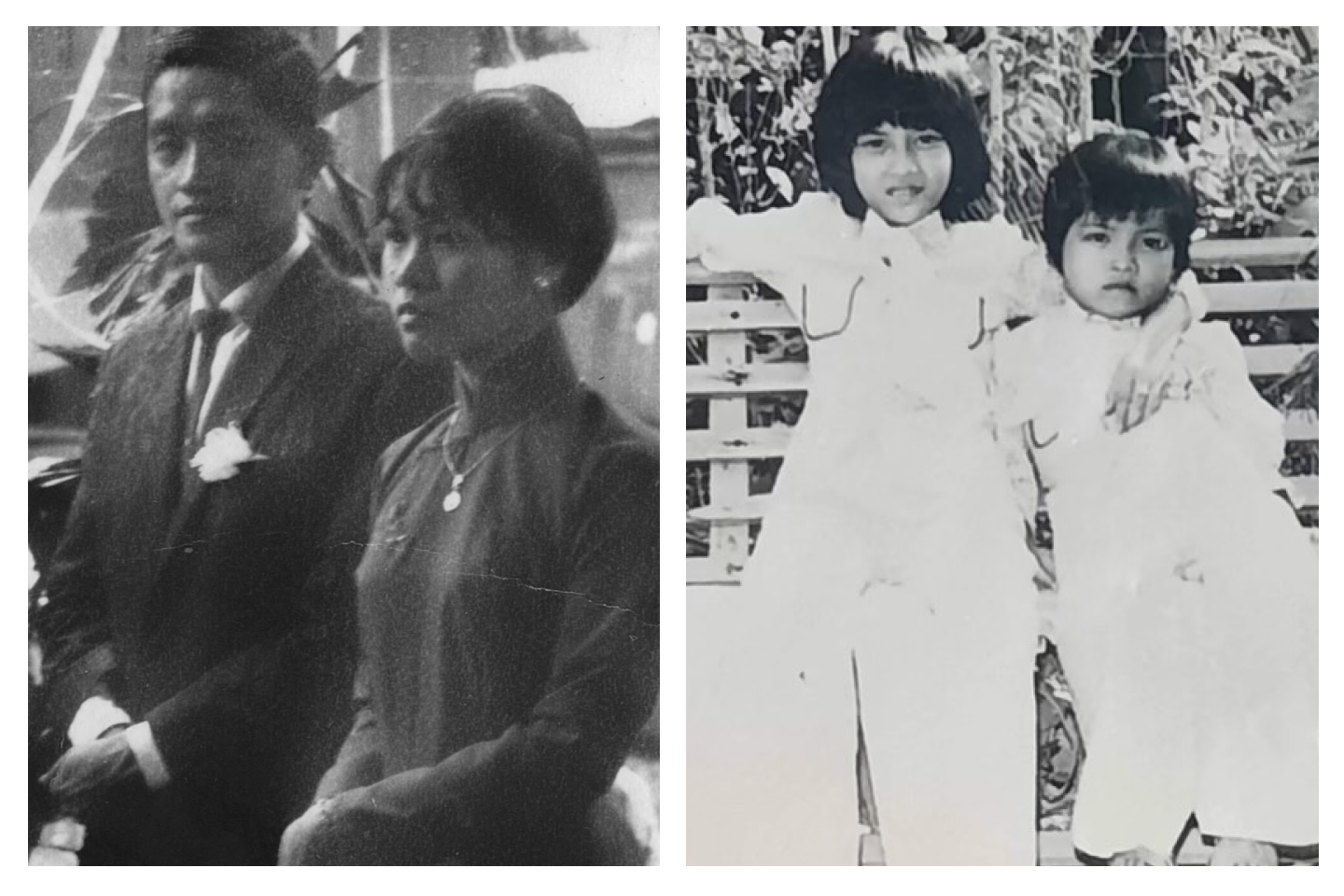
Dinh Du and Hongyen Dao raised five children, including daughters Kieu Thuy and Nga, in Cần Giuộc. (Courtesy of Yvonne Vu)
Bit by bit, week by week, a boat took shape in the brush near a fisherman’s wharf. Dinh, the ant, assembled a 32-foot wooden hull. Sturdy. Solid. Reliable. He built a top deck. He built and installed an engine.
Dinh planned for 50 people, enough to carry his household and extended family. But then word got out. Local villagers learned of the plan and begged for a spot. Dinh didn’t have extra space, but didn’t turn them away, either. He said yes to more than 30 additional passengers.
Finally, May 23, 1982, arrived. Three cars took the family from Cần Giuộc to Vũng Tàu. They gathered in a hut near the wharf. As darkness set in and the night turned still, Dinh told his five children, “When I say go, you go. No looking back!”
The moment came. A pitter-patter of feet darting through the jungle bordering the shoreline. Dressed in black, they ran through the rain, losing slippers in the mud and continuing barefoot. Nga, the family’s 8-year-old, grabbed her sister’s hand, yelling, “Where are we going?” Kieu Thuy, 12, pulling her sister along, burst, “We’re going to America!”
Eighty-three people packed tightly onto the boat, stuffing supplies underneath them. Dinh powered on the engine, snapping the quiet. The boat jolted, then built speed, heading into the open waters of the South China Sea. Hearing a buzz behind them, the passengers looked back. Two công an boats cut through the water, giving chase. Dinh cranked the engine harder.
“I remember the feeling,” Kieu Thuy says, “of the water on my face, as my dad sped up.”
An estimated 2 million Vietnamese fled by sea in the decades following the fall of Saigon. Rowboats. Flatboats. Fishing boats. Another million fled Laos and Cambodia. Some relocated via orderly evacuation and resettlement programs in North America, Europe or neighboring Asian countries. Many others took more desperate measures. Between 200,000 to 600,000 Vietnamese died from capture, drowning or starvation.
These asylum seekers came to be known as Vietnamese boat people, a name that has come to be regarded as pejorative — the sort of dehumanizing language often used in indexing immigrants. Other displaced people in recent years — be it Cubans or Haitians crossing the Atlantic to Florida, or Afghans fleeing to Australia — have also been deemed “boat people.”
Tracey Nguyễn Mang is the founder of Vietnamese Boat People, a non-profit that preserves stories of the Vietnamese diaspora in podcasts and public programs. Her family escaped when she was 3, and she recalls growing up with a stigma that was assigned to the older generations and inherited by the younger — the persistent idea that being a boat refugee meant “being inherently desperate.” The stigma created “a culture that you don’t show your vulnerabilities.”
“There’s a lot of unspokenness, not just from the public, but even within families,” Mang says. “Part of that is the trauma. Part of it is culture. Part of it is generational language barriers. It takes decades, when it comes to history like this, for communities to even be comfortable talking about it.
“When you migrate to a different country, your only focus is to survive. It’s to assimilate. It’s to give your child a life you risked everything for. You’re not worried about publicizing your hardships. You’re really just head-down surviving.”
Today, second, third and even fourth generations are unpacking what it took to come of age in a different world. Mang says they are reclaiming the idea of what it meant — and what it means — to be boat people.
“They were not desperate,” Mang explains. “They were courageous. They were survivors. And not only do they survive their journey, but they had the resilience to come to a country and rebuild their lives.”
The South China Sea is larger than the area of India. From Subic Bay in the north to the Strait of Malacca in the south, its 1.4 million square miles touch the beaches of Vietnam and Malaysia, of Singapore and Brunei, of the Philippines, Indonesia, China and Taiwan. Two-hundred and fifty-some-odd land features — islands, reefs, shoals — dot waters defined by a complicated history of critical geopolitical trade passages and conflicting territorial claims. Its edges both guard from outsiders and connect the Indian Ocean to the Pacific, linking one part of the world to the other.
Dinh Du pushed his hand-built engine to its brink, charging into those waters. Glancing back over his shoulder, he saw the police boats fade behind. After all the prep, all the planning, the escape was no longer about running, but instead about surviving. Their hopes hinged on two options: rescue by a passing boat or making it nearly 700 miles to Singapore. The alternatives? Capture or death.
Two days and three nights passed. Chapped by the sun and low on supplies, the 83 aboard drifted along nearly 400 miles south of Ho Chi Minh City, somewhere east of the Malaysian coast. They spotted passing ships over the previous days but none stopped. By now, they were halfway to Singapore. There was no turning back.
That third night was a particularly calm evening, darkness divided by the glint of lapping waves reflecting a big moon slung low. Emptiness everywhere.
Then the leak began.
It was around 3 a.m. on May 26, 1982. The sea seeped in slowly, at first, soaking food and clothes stored along the bilge. Some flinched awake, feeling the ocean upon their feet. As the boat jerked, Dinh told everyone to remain calm. He was prepared for this, he said. He activated an electric pump he installed in case of such an emergency.
The pump gargled, burped, sputtered. Nothing.
Everyone aboard scrambled and flailed, cupping hands, scooping water. One distraught passenger, a villager, jumped overboard, leaving water rippling in place, never resurfacing.
In the chaos, Kieu Thuy watched her father wrench at a pump that wouldn’t respond. She saw the moment wash over him. Bare acceptance. In Vietnamese he said to her, “I can’t fix it.”
Dinh reached for the lone distress signal on the boat. Pressing his eyes closed in prayer, he raised one hand into the air and fired a single flare streaking into the night sky. The pop above lit up an empty sea.
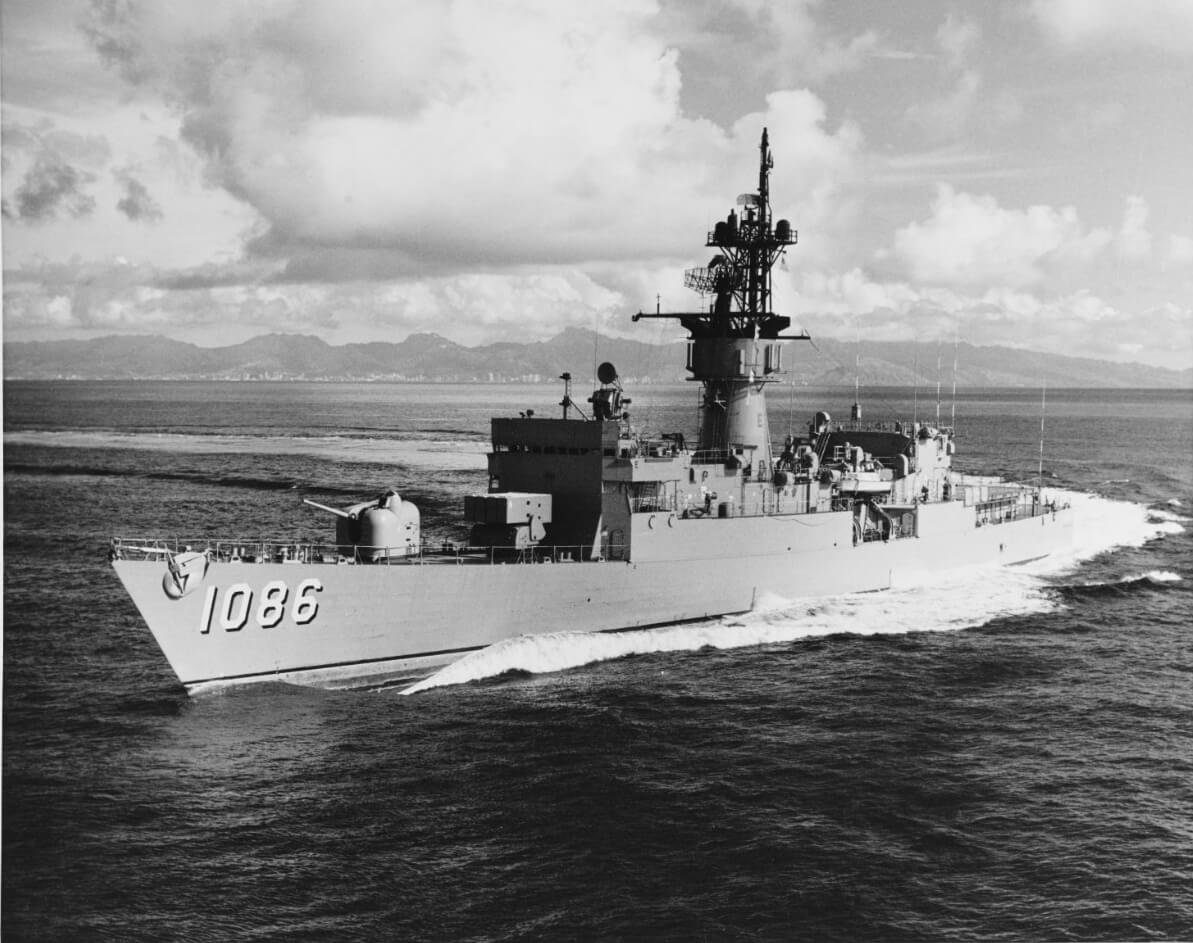
The Brewton was home to 18 officers and 260 sailors, enlistees from all over the United States. (National Archives and Records Administration)
The USS Brewton’s six-month 1982 WestPac deployment set out from Pearl Harbor in late April, taking the ship and its men to Subic Bay in the Philippines. Commissioned in 1972, the 438-foot-long Knox-class frigate was a “sub-hunter.” Initially tasked with tracking Soviet submarines, by ’82, the ship was active, but growing dated. Its radar display amounted to indistinguishable green blobs on a black screen. More glaringly, it wasn’t yet equipped with satellite navigation.
“We were still shooting stars,” says Jack Papp, a surface warfare officer.
The Brewton was home to 18 officers and 260 sailors, enlistees from all over the United States. Some were there because they chose to be — young guys from the Naval Academy, ROTCs or officer training school. Others perhaps as a consequence, maybe having once stood in front of a judge who suggested he join the Navy instead of the correctional system. Some were young men seeing the world for the first time. Others were old-timers who saw heavy action in Vietnam. They were White, Black, Asian, Latino. They sent messages home using ham radios.
“We were probably more representative of what the country looked like than you’d imagine,” says John Popek, a main propulsion assistant on the ship.
That is, even if the country was unsure how to feel about them.
“You have to remember, at this time, people did not thank you for your service,” Popek says. “It was a different time. Morale was terrible. There was still a hangover from Vietnam.”
Crossing the Pacific, the Brewton in May 1982 arrived at Subic Bay, where it was scheduled to accompany the USS Ranger, an aircraft carrier, through the South China Sea to the Strait of Malacca. Days rolled together. “At sea, you sort of go into auto-mode,” says Papp, 24 years old then, 65 years old now. “You do division work. You take 12 off. You do it again.”
The early morning hours of May 26 were no different.
Until a single burst of light popped over a far horizon.
It was around 0400 when a call came from the signal bridge reporting what was potentially a distress signal in the distance. Capt. Owen C. Martin Jr., in his final night as Brewton’s commanding officer, had a decision to make. Pursue or stay the course.
In the engine room, Popek felt the boat lurch, its 35,000-shaft horsepower steam turbine powering down.
“I immediately knew something was happening,” he remembers. “Ships are not great unless they’re moving forward. You don’t just slow down.”
Word spread that something might be out there, somewhere. Martin sent a deckhand to wake up Capt. Robert K. Bolger, who was scheduled to be sworn in later that day to relieve him as commanding officer. If they were to attempt a rescue, any refugees taken aboard would be his responsibility.
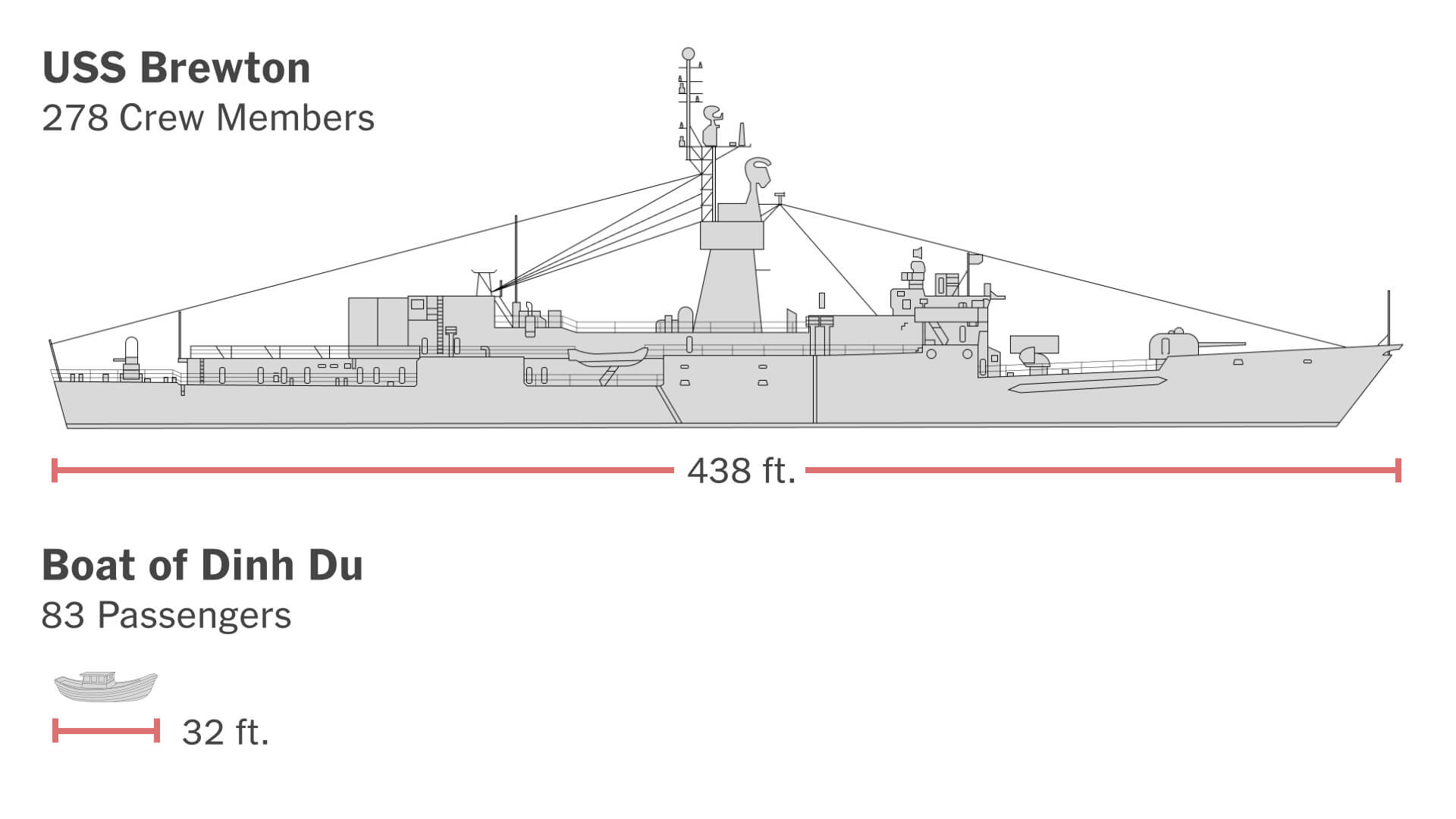
As Bolger rose, Martin called for the captain’s gig and a utility boat to investigate, sending Brewton’s two smaller vessels out into the dark. A few minutes later, they radioed back, reporting a small wooden boat, roughly 30 feet, was located and in peril, taking on water. Given orders to inspect, the Navy sailors boarded the shaky craft. One of the Vietnamese passengers, a man who’d previously been jailed for working with the U.S. Army, translated between Dinh Du and the U.S. sailors. Those sailors radioed back to Martin that the boat posed no threat. Martin responded by declaring all 82 aboard as refugees and moved the Brewton next to the boats.
On deck, a row of sailors lined the railing, looking out into the black. Some pointed, making out some shapes in the distance.
The Brewton’s spotlight lit up the water.
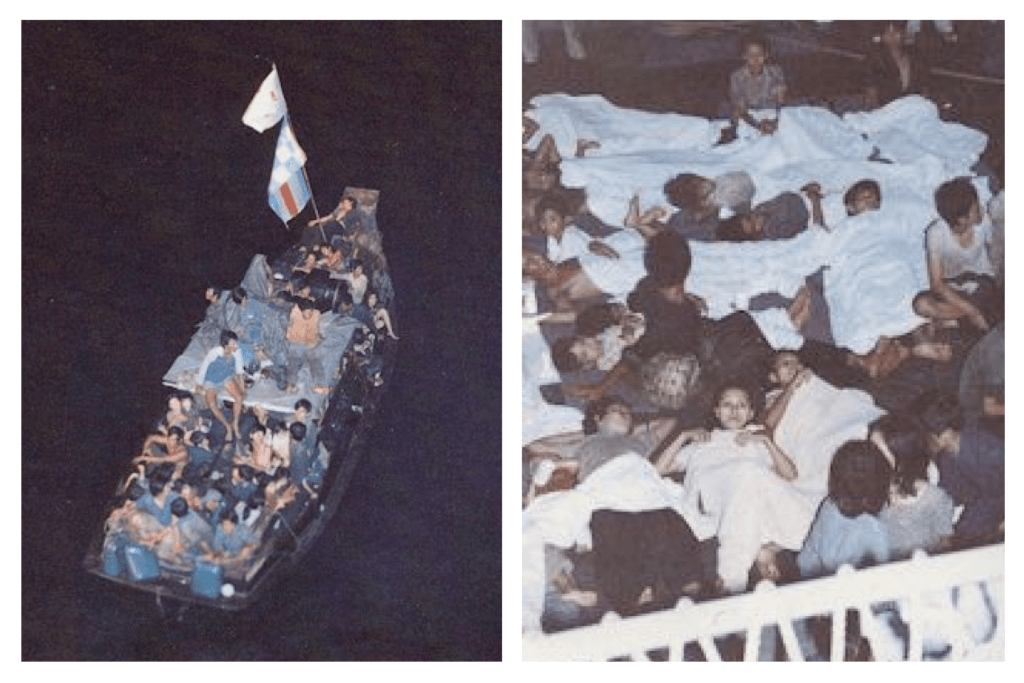
The 82 refugees left behind all their belongings when boarding the USS Brewton. (USS Brewton cruise book)
“I just remember being up there as we pulled alongside it, seeing all the people on that thing and just thinking, ‘How the hell is that thing even floating?’” says Dave Taormina, a 20-year-old radioman at the time.
“They were in a state of shock,” Popek says.
The refugees climbed onto the two smaller naval vessels before boarding the Brewton, leaving all their belongings behind. The hull of the frigate rose like a wall in front of them. They arched their necks, looking up 50 feet to the deck above, seeing faces looking back at them.
One by one, the 82 climbed up the Brewton’s accommodation ladder, reaching the top, grasping at sailors’ hands to pull them aboard. Some Vietnamese-speaking crew members surveyed the refugees. Martin and Bolger urged everyone to gather whatever extra clothes or supplies were available. Seeing some babies among the rescued, Bolger searched the Brewton for humanitarian goods, knowing diapers were stored somewhere.
Other sailors set up a medical triage on the fantail. Some rushed to warm food in the galley. Others stocked showers with fresh soap. Mattresses were spread around the deck. Spare clothes were distributed, sending children scampering away in T-shirts down to their ankles.
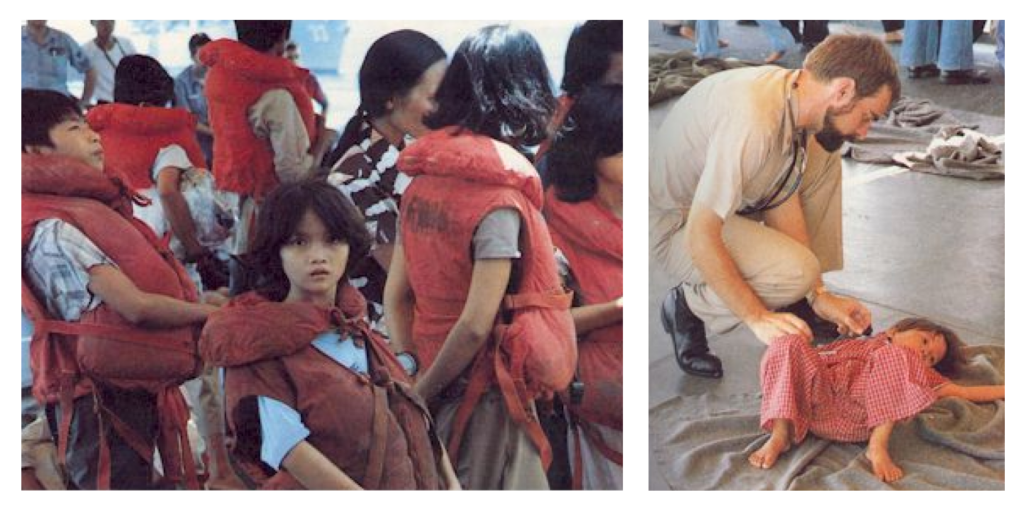
Children were among the refugees taken aboard the Brewton. (USS Brewton cruise book)
The sailors set up a projector. Everyone settled onto the mattresses with bowls of Rice-A-Roni. “Saturday Night Fever” flickered upon a screen, making it the first American movie most of them would see.
Concerned about leaving an unmanned boat on the open sea, a few sailors shot 50-caliber machine guns into the water, sinking Dinh Du’s boat.
All told, the refugees spent less than half a day aboard the Brewton. The USS Fox, an American cruiser, was deployed to pick them up for transport to Singapore. Under an afternoon sun, the 82 were lowered into a few small launches for transfer to the Fox. Drifting back out into the South China Sea, with life jackets cinched tight, they looked up and waved.
“Cảm ơn! Cảm ơn!”
Thank you. Thank you.
Leaning over the railing, the sailors waved back.
Dropped off in Singapore by the USS Fox, the 82 Vietnamese boat people entered the UN Commission for Refugees, hoping to be accepted, but fearing a quick return to Ho Chi Minh City. When resettlement options were presented in areas of North America and Europe, they felt profound relief.
Dinh Du, then 42, told officials he had a brother living in Southern California and hoped to join him there.
After three months in Singapore, the family was shipped to Galang Refugee Camp in Indonesia to await processing for relocation in the United States. They learned basic English and took classes on American customs and financial literacy.
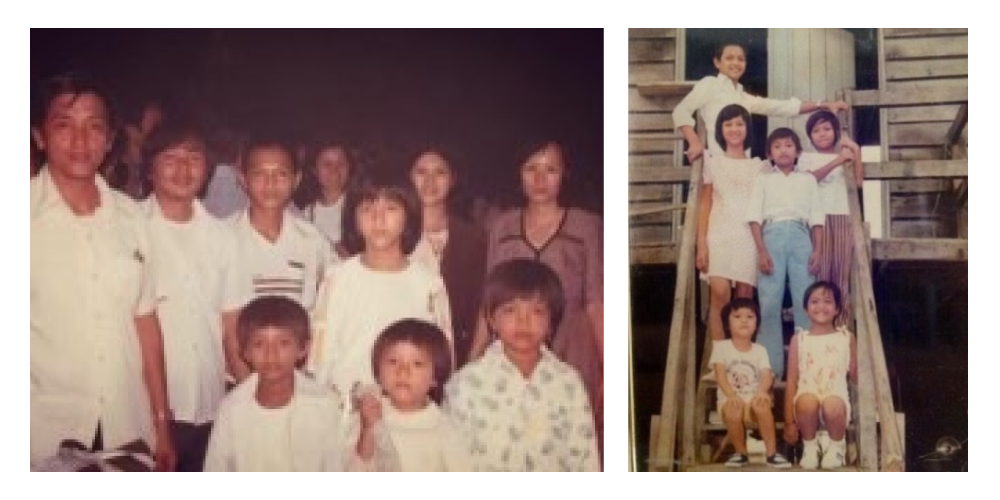
After three months in Singapore, the family was shipped to Galang Refugee Camp in Indonesia to await processing for relocation in the United States. (Courtesy of Yvonne Vu)
Six months later, in the spring of 1983, Dinh and Hongyen, along with their five children, arrived in the United States. They were prepared. Hongyen had the family savings — roughly $7,000 saved up for years from the battery business — sewed into pockets of her clothes at the time of the rescue.
They settled about 30 miles south of Los Angeles, near the Little Saigon section of Orange County, what is now home to nearly 200,000 Vietnamese-Americans — the oldest, largest concentration of Vietnamese-Americans anywhere in the United States. The dominion is a point of pride for those forced to leave so much of themselves behind. Signage in Little Saigon’s major commercial area is almost exclusively in Vietnamese, as are television stations, radio stations and newspapers in the area.
When the time came to fill out U.S. citizenship forms, all the children picked American names. Among them, Kieu Thuy chose Yvonne. Her sister Nga chose Kandi.
In time, they created families of their own. Yvonne met her husband, Douglas Vu, a fellow first-generation Vietnamese immigrant, and had two children. They built a comfortable life in Fountain Valley, Calif., about five miles from her parents in Westminster, near Little Saigon.
As her children grew up, Yvonne shared stories that felt like fables. How grandfather built a boat with his own two hands. How they ran through that jungle in the rain. How that searchlight appeared way out in the distance, out in the South China Sea, turning in their direction from an American ship.
These were the bedtime stories.
The ones her daughter fell asleep to.
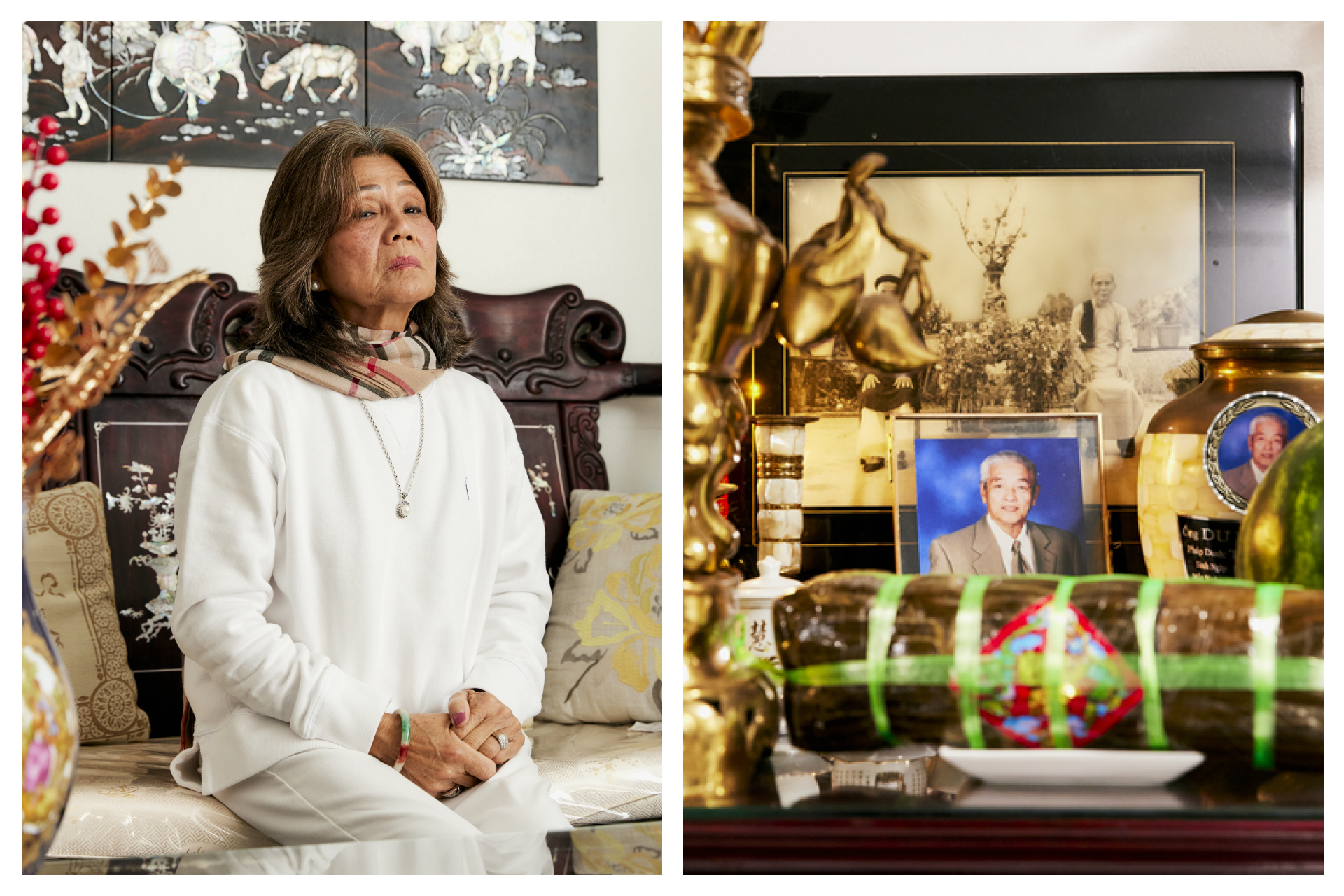
Hongyen Dao, left, and Dinh Du fled Vietnam to provide a better life for their children. (Jennelle Fong for The Athletic)
Hongyen Dao, 78, sits with perfect posture, smiling under smoke-gray hair, hands crossed upon her lap. She’s lived in this home in Westminster for 20 years. Her garden is spectacular, complete with orchids planted long ago.
It’s late in the day, that time when an afternoon sun hits just right, lighting up the shell inlays of ornate cabinets and the dark cherrywood of Hongyen’s hand-carved chairs. The living room is bright and one story turns into the next. A few pictures are shared with Hongyen and her daughters, Yvonne and Kandi; pictures recently pulled out of John Popek’s attic. Photos of American sailors and Vietnamese refugees milling about a crowded boat deck. Photos of children being lowered onto smaller boats. Photos of their family in life jackets waving goodbye to the men atop the deck of the USS Brewton.
All three women cover their mouths and fight back tears. Yvonne and Kandi shuffle through the pictures, narrating along.
“That’s my brother!”
“That’s my cousin!”
“Oh my god.”
“I’m going to cry.”
“Our uncle!”
Hongyen leans forward quietly, brushing a hand across each picture. She says nothing, but her eyes say everything. When the time came to leave Cần Giuộc four decades ago, she nearly called off the whole escape. Her mother, elderly and frail, was in no condition to journey into the South China Sea, and Hongyen couldn’t bear to leave her behind. There would be no one left to take care of her.
Explaining this quietly, Yvonne shakes her head and puts up a hand. “We don’t talk about that,” Kandi whispers.
Hongyen never saw her mother again.
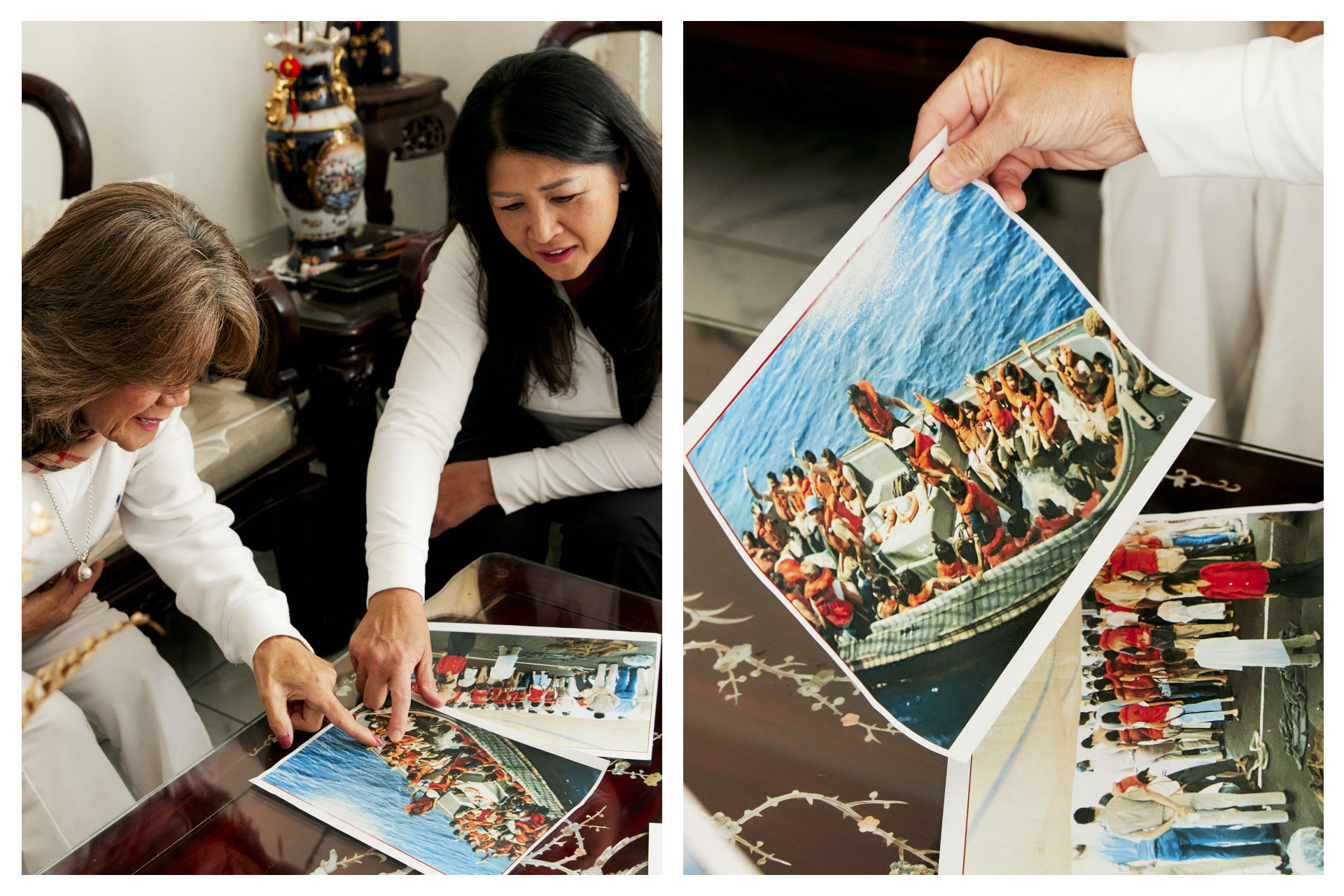
Photos of the rescue shared with the family brought back waves of memories. (Jennelle Fong for The Athletic)
With each picture, every moment comes back to the surface. The room quiets as Hongyen speaks in Vietnamese.
“All we wanted,” Yvonne translates, “was a better life for the children.”
As afternoon turns to evening in Little Saigon, a car door shuts outside Hongyen’s house and all heads turn toward the door.
Here is Lilia Vu.
“Hiiiiiiiiiiiii!” they all cheer.
Hugs give way to conversation and Lilia explains she hoped to have gotten here earlier, but an afternoon photoshoot with a new sponsor ran long. Then traffic from Los Angeles was brutal. She’s still in full makeup from the photoshoot and jokes that her face is sore from smiling. It’s been a hectic day and she’s barely eaten. Of course, Yvonne has a bowl of pho waiting on the table for her.
Lilia is a 26-year-old professional golfer. A former UCLA star, she’s spent the last five years navigating the highest highs and the lowest lows of the pro game. She has the disposition to match — charming and candid out of the spotlight, quiet and uneasy in it. She’s proud to say she spends half her free time devouring books, and embarrassed to say she spends the other half on TikTok.
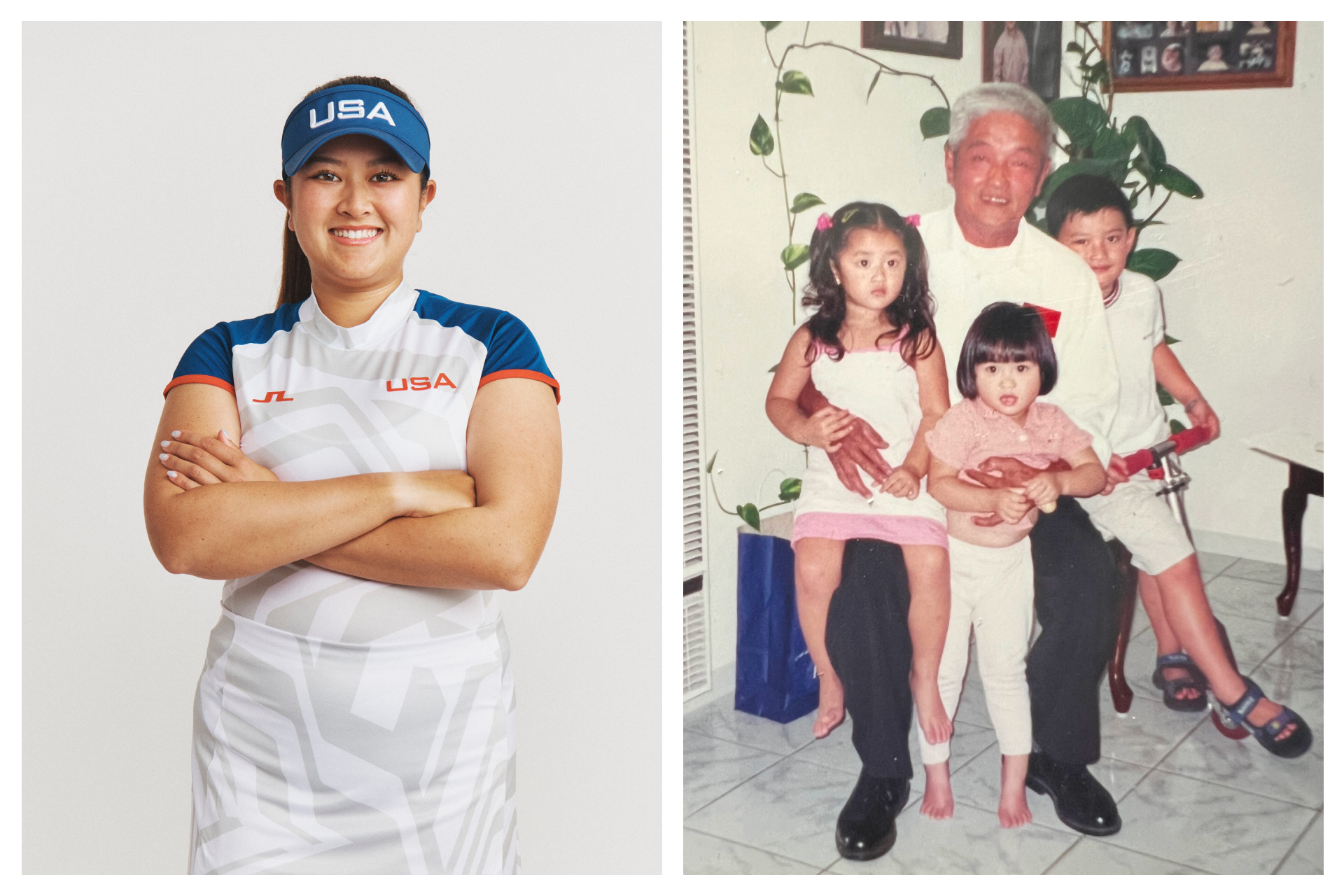
Dinh Du, center right, stressed to Lilia Vu, pictured at age 4 with cousin Regina and brother Andre, that she needed to find joy in her game to achieve her goals. (Courtesy of J. Lindeberg and Yvonne Vu)
Navigating the world has gotten a little trickier of late. Lilia has spent most of the last 15 months in some sort of dreamscape. Five wins. Two major victories. Nearly $5 million in earnings. Endorsements. Fame. Attention.
She won her first LPGA Tour event in February 2023. Then won her first career major, the Chevron Championship, eight weeks later. Struggles followed, leading to fear those wins might’ve been flukes, but then a win at the AIG Women’s Open made Lilia the first American woman to win multiple majors in a single year since Juli Inkster in 1999.
All this from the same player who finished the 2020 season ranked 1,330th in the world.
Today, after 28 weeks ranked No. 1 in the world between August 2023 and March 2024, Lilia is a bona fide star.
But here, in her grandmother’s house, Lilia is still Kha-Tu Du Vu, her given name. The little girl who grew up speaking Vietnamese to both her parents and grandparents and copying the swing of her older brother, Andre, who would later play golf at UC Riverside.
Lilia eats her pho and then, as evening settles over Little Saigon, walks into the living room to join her grandmother. Side-by-side on the sofa, they lean close together, sharing words only one another can hear. They both smile. Then Lilia puts an arm around her and leans in close, giving a gentle squeeze.
Nearby, atop an ornate bookshelf, pictures of Dinh Du sit next to a burning candle. A gold urn sits under a red flower.
Growing up, Lilia looked at her grandpa — her “ông ngoại” — as a sweet old man who worked at an auto shop during the day and doted upon his wife at night. Dinh cooked dinner for Hongyen nearly every evening. He built her a green awning in the backyard and tended to a koi pond. He had a bad back and sore knees.
Only later did a different version come into view.
In March 2020, Lilia’s young career felt fully stalled. Once a college All-American and the No. 1-ranked women’s amateur in the world, she turned pro a year earlier and immediately earned status on the LPGA Tour. Then, just as quickly, she lost that status. Missed cuts stacked up. Bad thoughts crept in. Maybe she was never that good in the first place. Perhaps law school was a better option.
Amid a growing pandemic, Lilia was scheduled to play a low-level tournament in Florida, but needed to visit her grandfather first. He was in a hospital with some heart issues. Doctors expected a full recovery, but Lilia wanted some time with him before traveling. She opened up about how she was feeling.
“I told him that it was all too much, and I just — I didn’t have it,” she says now. “I couldn’t figure out how to have fun anymore.”
Dinh Du saw the stress in his granddaughter’s eyes and told her to stop worrying and start playing. He said to focus on her golf and ignore everything else, to find joy in the game again.
Lilia heard him, but maybe didn’t understand him. Not fully, at least. She was 22. The tournament in Florida ended with another missed cut, and Lilia returned home to learn she was too late. Her grandfather was in emergency care and unresponsive. He died March 9, 2020.
In that ending, a journey once foretold could finally be fully understood. How this mechanic from Cần Giuộc breathed life into generations. How a 32-foot boat built by his hands changed so much for so many. How he never once took credit for any of it.
“He didn’t get the family out of there because he wanted praise for it,” Lilia says. “He got them out of there because he had to get them out of there. It’s just mind-blowing to me that all this had to happen for me to have the chance to be here today.”
Four years after Dinh Du’s passing, his granddaughter, Lilia Vu — Kha-Tu Du Vu — will travel to Paris this summer. She’ll board a plane, cross an ocean, and stand upon the biggest stage in the world, one so big it can be seen from the villages of Vietnam and the shores of the South China Sea. Lilia will represent the United States in the XXXIII Olympic Summer Games.
“I’ve learned that if you want something, you have to go,” she says.
Epilogue
All told, five members of the USS Brewton crew, men ranging from 65 to 80 years old, were able to be tracked down for this story. Capt. Martin died in 2012. To a man, each said the same thing about May 26, 1982 – the rescue was the single greatest highlight of his military career. All were awarded the Navy Humanitarian Service Medal for their actions that morning.
“You drop them off and wonder, you know, are they gonna be OK?” Jack Papp said recently. “Where are they gonna go? What’ll happen to these people?”
“I’ve always thought about those folks,” said John Thompson, now a 68-year-old CFA, then a 26-year-old lieutenant junior grade, “and just wondered how things have turned out for them.”
Bob Bolger, who took over as the Brewton’s commanding officer the same day the Vusietnamese were transferred to the USS Fox, is 81 now. He likes hammy jokes, giving tours at the San Diego Maritime Museum, and hanging out with his 2-year-old grandson, Ryder. When contacted for this story this past winter, Bob didn’t quite believe what he was hearing — that a 12-year-old girl from that tiny boat in the South China Sea had a daughter on her way to becoming a U.S. Olympian.
He also couldn’t believe Hongyen, Kieu Thuy and Nga lived only an hour up the road.
So a reunion was arranged.
It was a Saturday morning in late May, nearly 42 years to the day that the Brewton came upon a small ship in a large sea. Bob ambled down a street along Coronado Island, not far from the Naval Amphibious Base.
Spotting “Capt. Bob” coming her way, Yvonne Vu brushed away tears and covered her mouth. Her sister Kandi did the same. Hongyen clasped her hands together, repeating, “Cảm ơn. Cảm ơn.” Thank you. Thank you.
Gathering on a small bench, all four shared stories of where they were and what they remembered. Yvonne told Bob she wished her father was still around to meet him. Bob said he wished the other men of the Brewton could meet the family.
Bob handed Yvonne his copy of the cruise book from the Brewton’s 1982 WestPac deployment. She leafed through alongside her mother and sister, all leaning together. Handing it back to Bob, Yvonne was met by an outstretched palm. No, no, he told her. You keep it.
“That should be in your family,” he said.
For the next generation.
(Illustration: John Bradford / The Athletic; graphics/motion design: Drew Jordan, John Bradford / The Athletic; photos: Jennelle Fong; Amy Remus / Getty Images; video: Brett Michel)